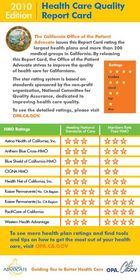SACRAMENTO, CA--(Marketwire - February 9, 2010) - Six out of the nine largest HMOs showed
improvement in their patient satisfaction ratings in the state of
California's 2010
Health Care Quality
Report Card. At the same time, California continues to lag on some
critical indicators of good care according to the
California Office of the Patient Advocate,
which released the annual Report Card today. The Report Card rates the
nine largest commercial HMOs in the state which cover nearly half of all
Californians.
"I am encouraged to see that more health plan members are satisfied with
the services from their health plans than last year," said Office of the
Patient Advocate Director Sandra Perez. "It's critical that Californians
have the information and tools available to receive the best value for
their health dollars. This information is also helpful to the health plans
in their efforts to improve the services and programs that they offer."
Specific findings in the 2010 Edition of the Health Care Quality Report
Card include:
-- For the first time, some health plans received four-out-of-four stars
for patient satisfaction. Kaiser Permanente Southern California,
PacifiCare and Western Health Advantage all received four-star ratings
from their members.
-- Kaiser Permanente Southern California is the first HMO health plan to
receive four stars in both meeting national standards of care and
member satisfaction.
-- Three HMOs -- Aetna Health of California, Anthem Blue Cross and Cigna
HMO -- showed improvements in both meeting national standards of care
and member ratings.
-- The ratings of the other three HMOs -- Blue Shield of California HMO,
Health Net of California and Kaiser Permanente Northern California --
remained the same.
"This year's Report Card shows some overall improvement in clinical care,
but also highlights specific areas where health plans need to provide
better care," said Perez. "For the 18 million Californians who rely on
HMOs for their health care, knowing how their health plan rates on various
indicators will help them make better health care decisions."
Areas needing improvement in the screening and/or treatment of certain
health conditions include:
-- Colorectal cancer screening rate has seen strong improvement in the
past five years, but the absolute rate is still 57 percent.
-- Chlamydia screening has also seen significant increases over the
past five years, but the average rate is still only 40-50 percent.
-- Almost 50 percent of commercially-insured children continue to
wrongly receive antibiotic drugs for conditions such as sore throats,
for which these medications don't work.
-- About 60 percent of patients needing continuous mental health services
receive that follow-up care.
Areas where clinical data measures show improvements:
-- Screening tests (blood sugar) for patients with diabetes have shown
steady improvement over the past decade and now average about 90
percent.
-- Cholesterol screening rates of patients with cardiovascular disease
have also steadily increased and now average about 90 percent.
To help make it easier for Californians to choose a health plan and
maximize the care they receive, the Office of the Patient Advocate
introduced an innovative new feature on its Web site,
opa.ca.gov, which allows consumers to
compare health plans based on what they offer and how they rate in key
areas. The new 'Compare Health Plans' feature, the first of its kind,
allows consumers to compare the health services and programs that plans
provide in four categories of programs or services that help health plan
members: 1) get fit and stay well; 2) take care of a health problem
(addressing 15 different health conditions); 3) use a personal health
record; and 4) learn rules to see doctors. This new tool provides
Californians even greater information when choosing the best health plan
for themselves and their families.
In addition to the annual Report Card, the Office of the Patient Advocate
offers other resources to help Californians get the most out of their
health care. These include health worksheets on making the most of doctor
visits, a guide on how to use your health plan, information on patient's
rights, and instructions for reporting problems or complaints with your
health insurance plan. All of these resources can be found on the Office
of the Patient Advocate Web site,
opa.ca.gov.
The Office of the Patient Advocate is an independent office in state
government that informs Californians about their rights and
responsibilities as health plan members and teaches them how to get the
most out of their health care. For more information about the Health Care
Quality Report Card or to see the detailed ratings, visit
opa.ca.gov. Copies of the Report Card
can also be obtained by calling 1(888) 466-2219.

